Shrimp Fried Cauliflower Rice {Paleo, Whole30, Keto}
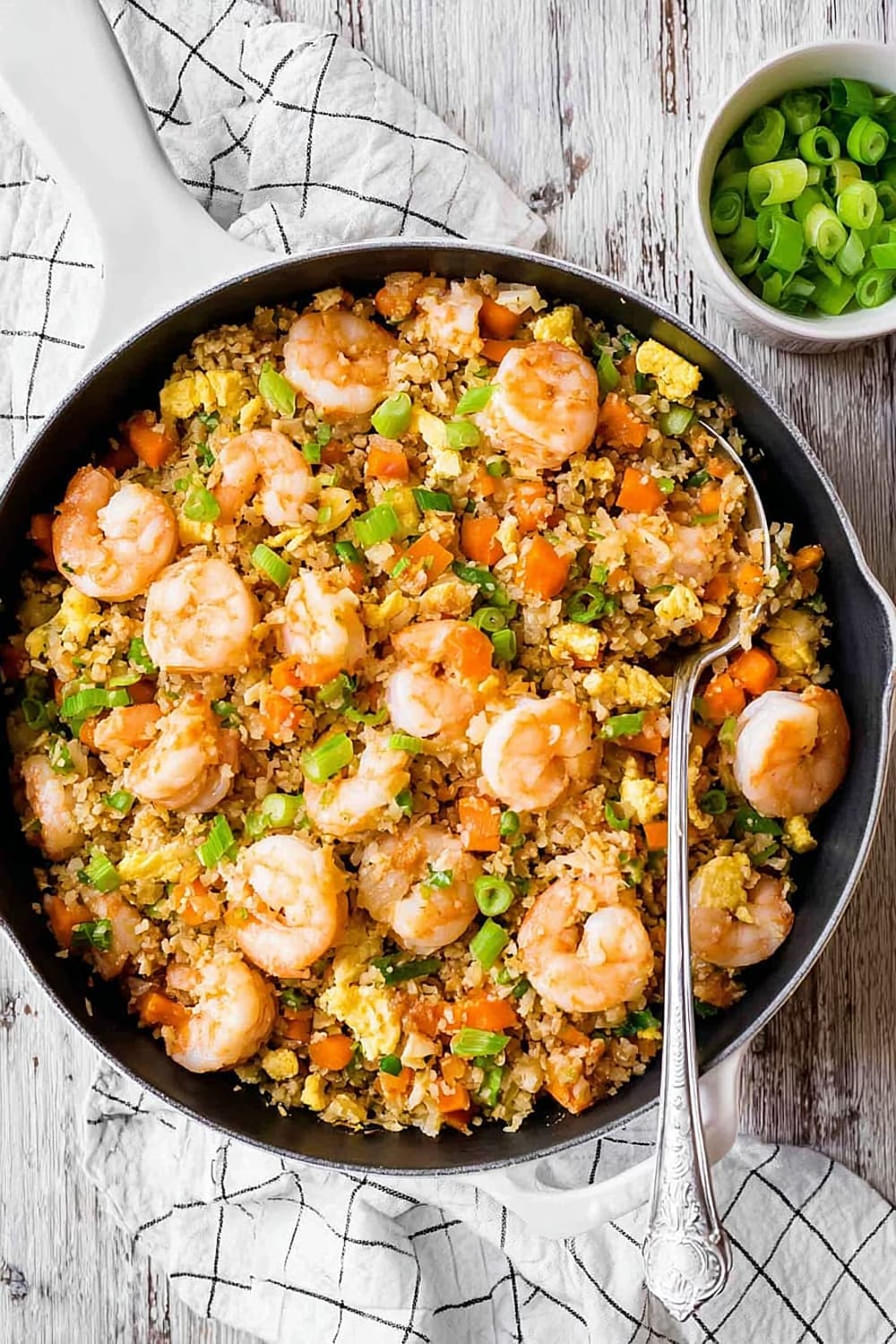
This recipe is basically the ultimate proof that healthy food doesn’t have to taste like cardboard or punishment.
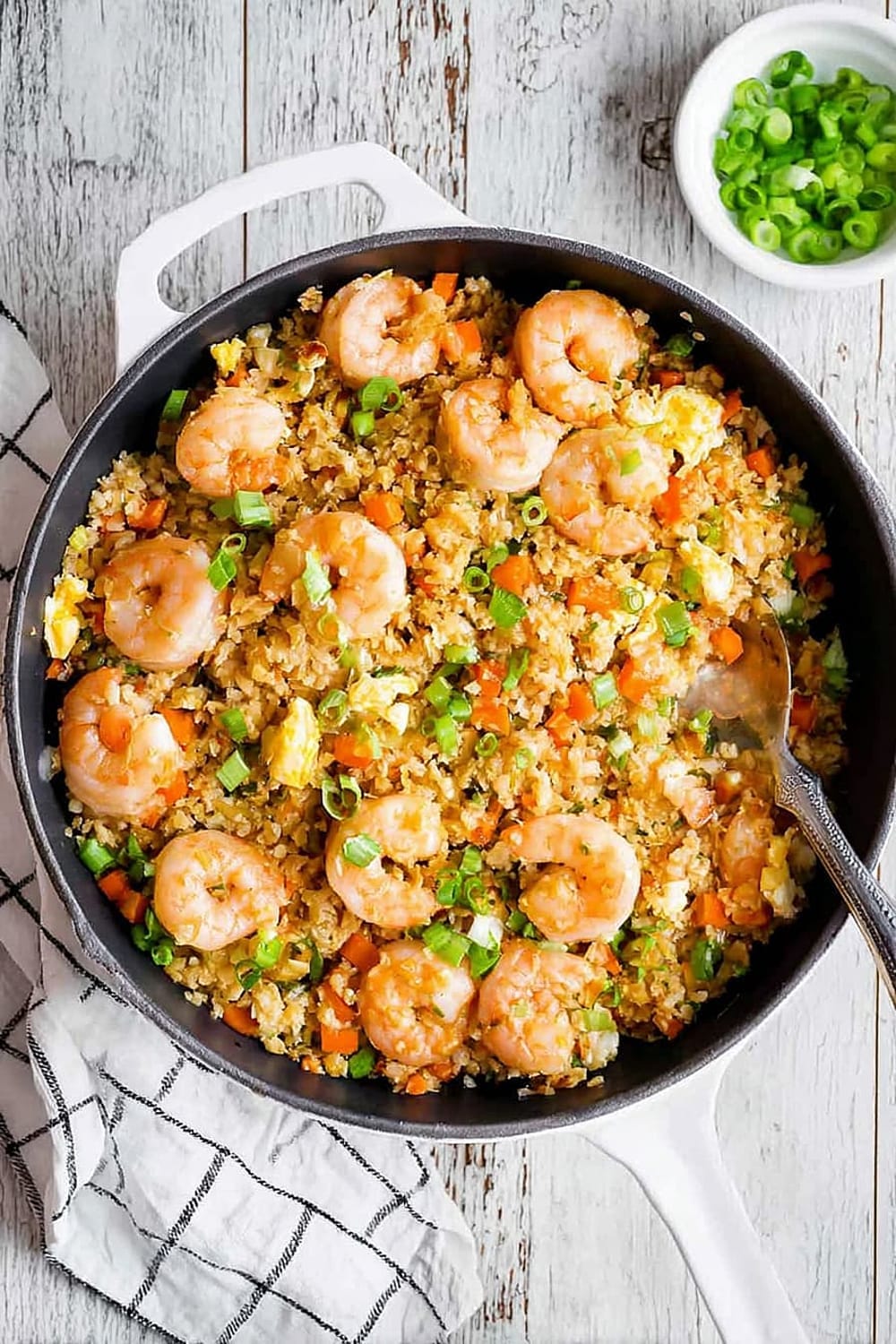
Picture this: all the savory, umami-packed satisfaction of your favorite takeout fried rice, but without the post-meal food coma or the guilt spiral that usually follows.
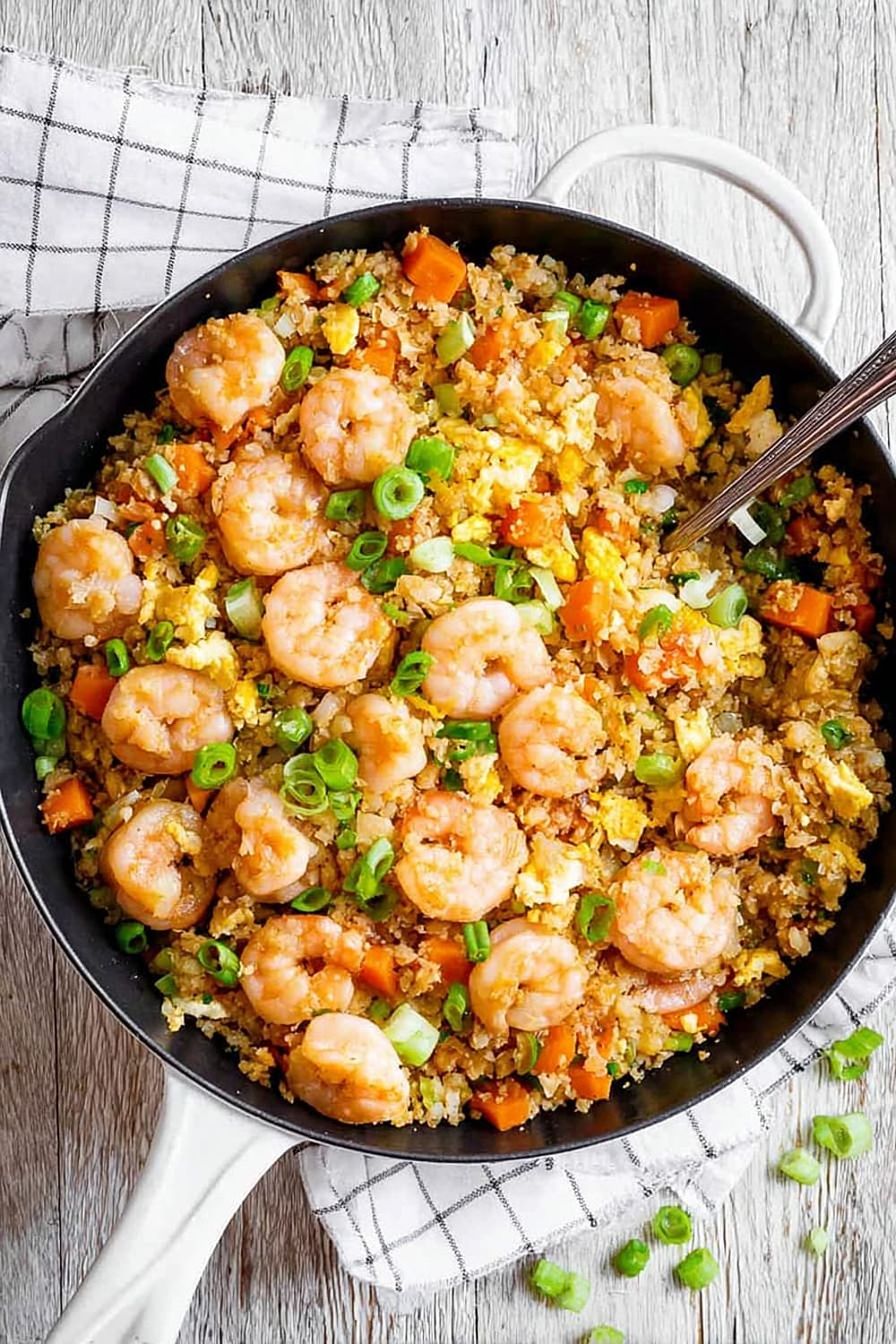
The magic happens when perfectly seasoned shrimp meets tender-crisp vegetables and fluffy cauliflower rice that’s been transformed with coconut aminos and sesame oil into something that’ll make you forget you’re eating vegetables.
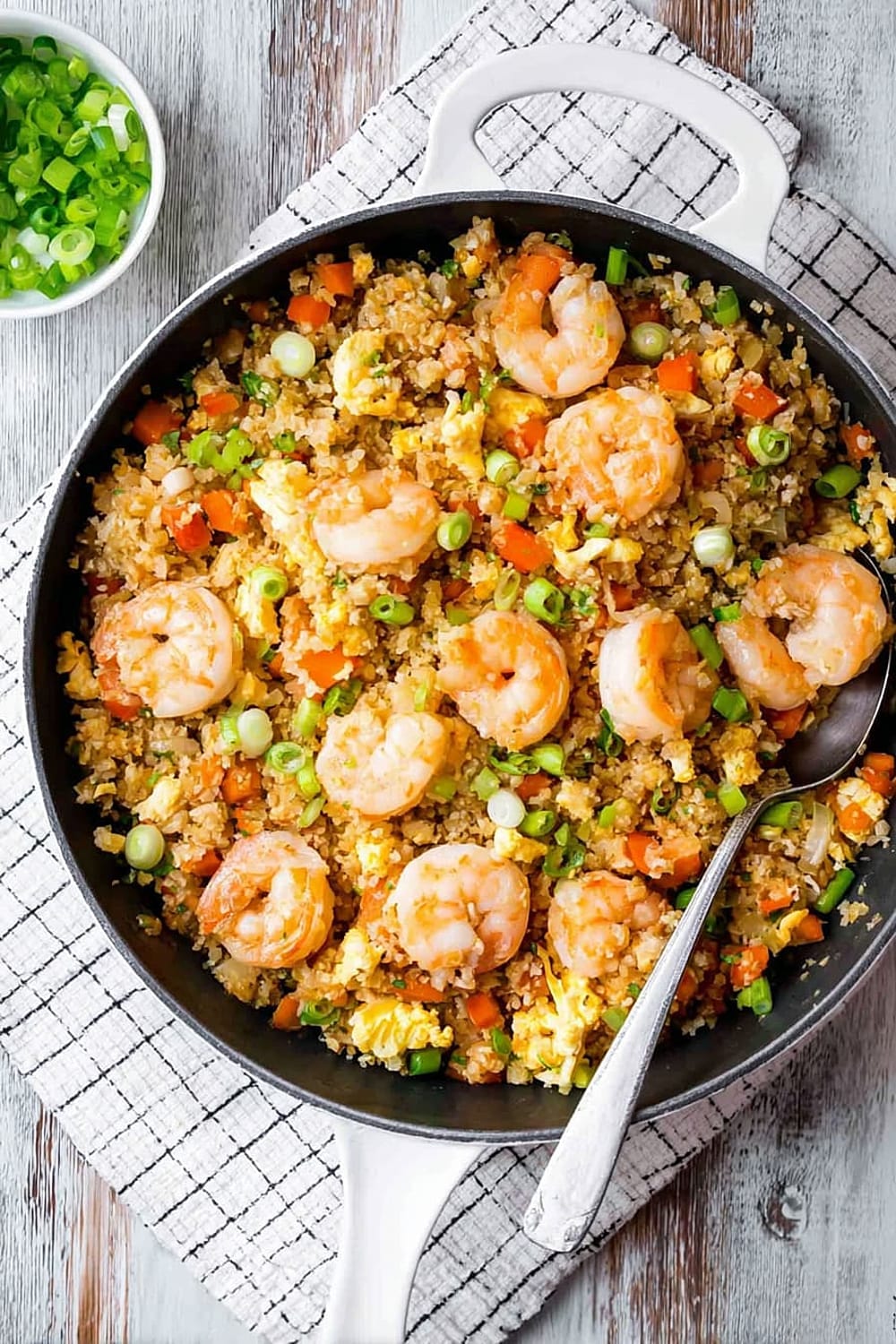
This is the kind of meal that tricks your brain into thinking you’re indulging while your body thanks you for all the protein, healthy fats, and nutrients you’re actually feeding it.
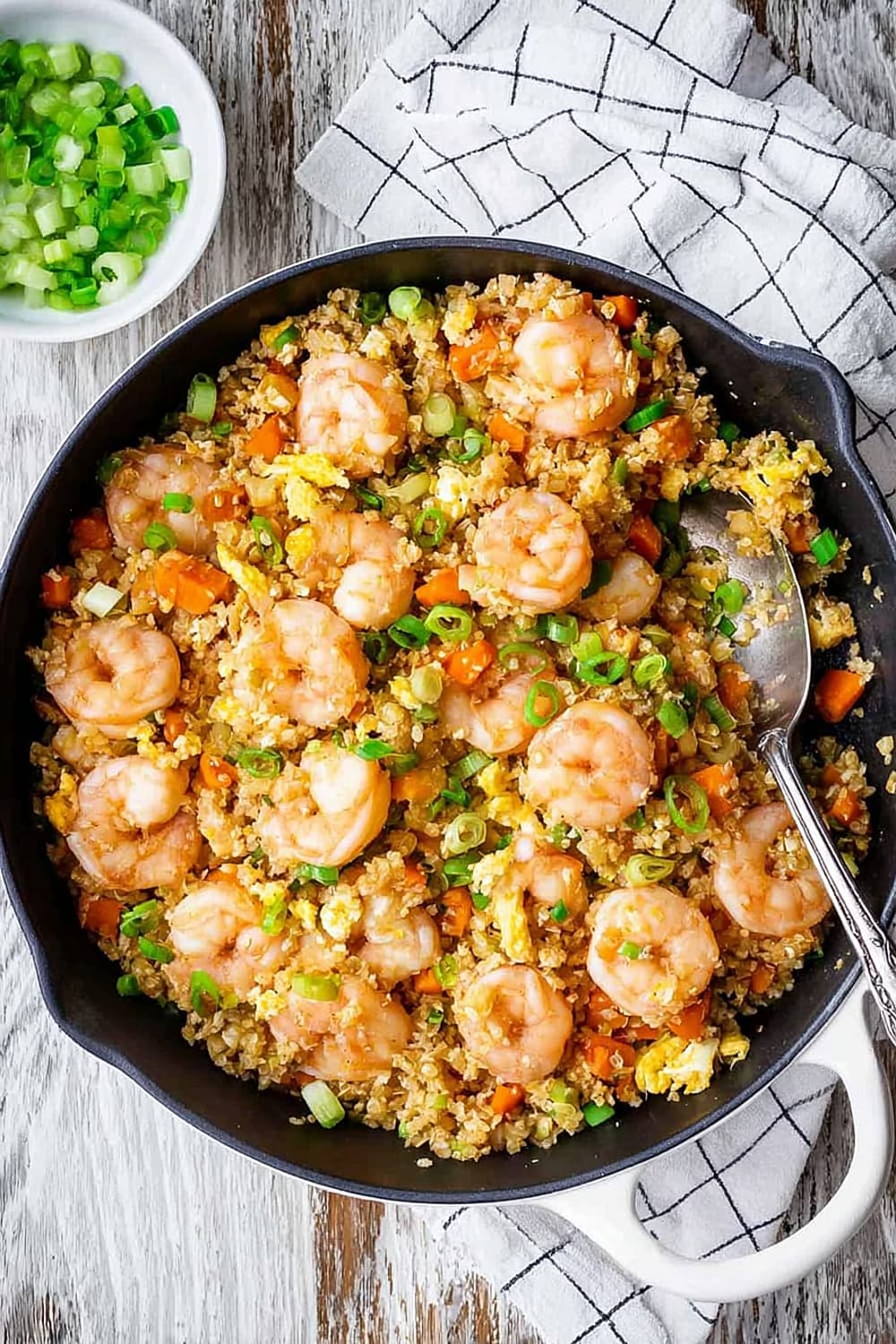
The best part is watching people take that first bite and get that confused look like “Wait, this is supposed to be healthy?” followed immediately by them going back for seconds.
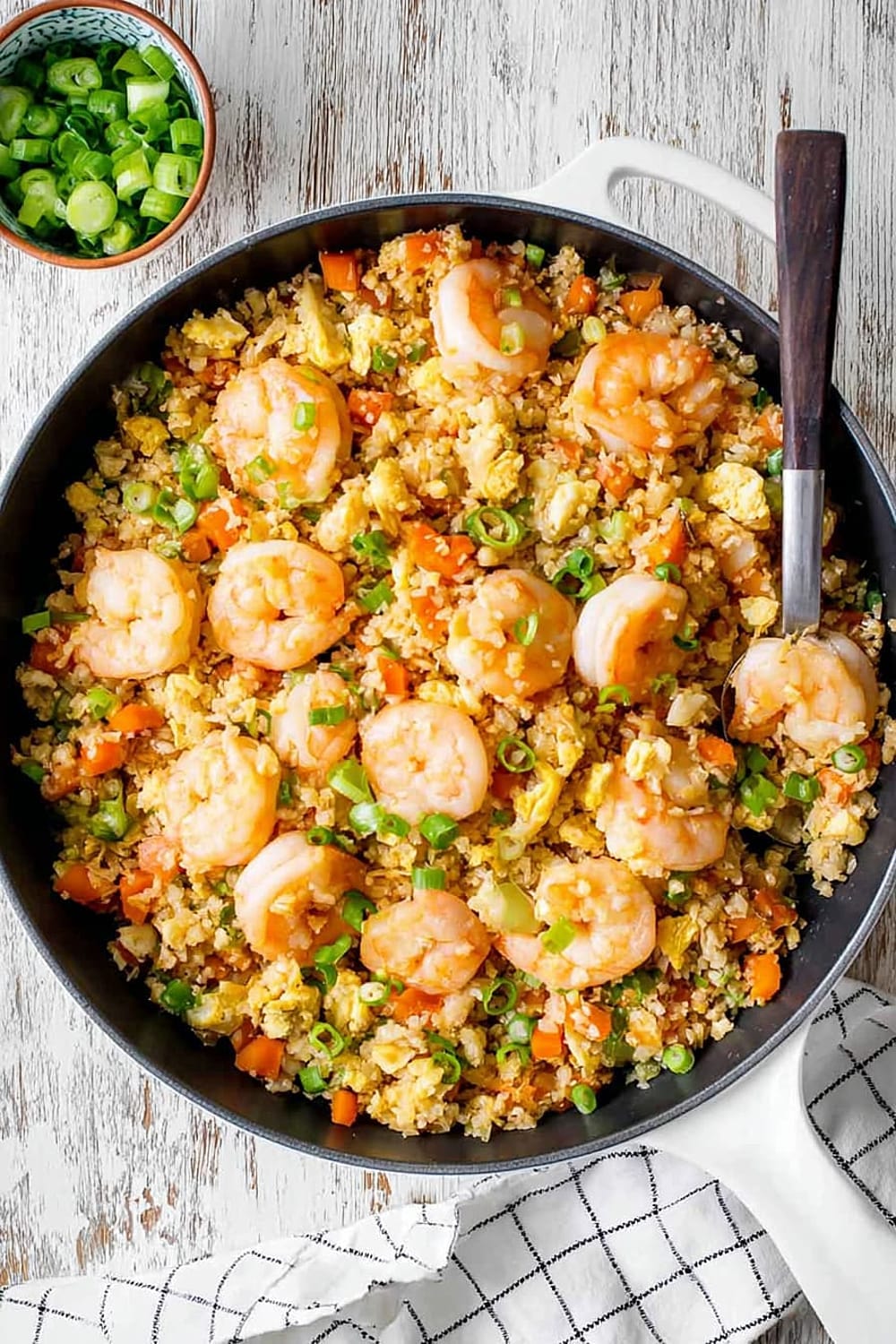
Ready in just 25 minutes from start to finish, this recipe is about to become your new weeknight hero and your answer to “What’s for dinner?” panic.
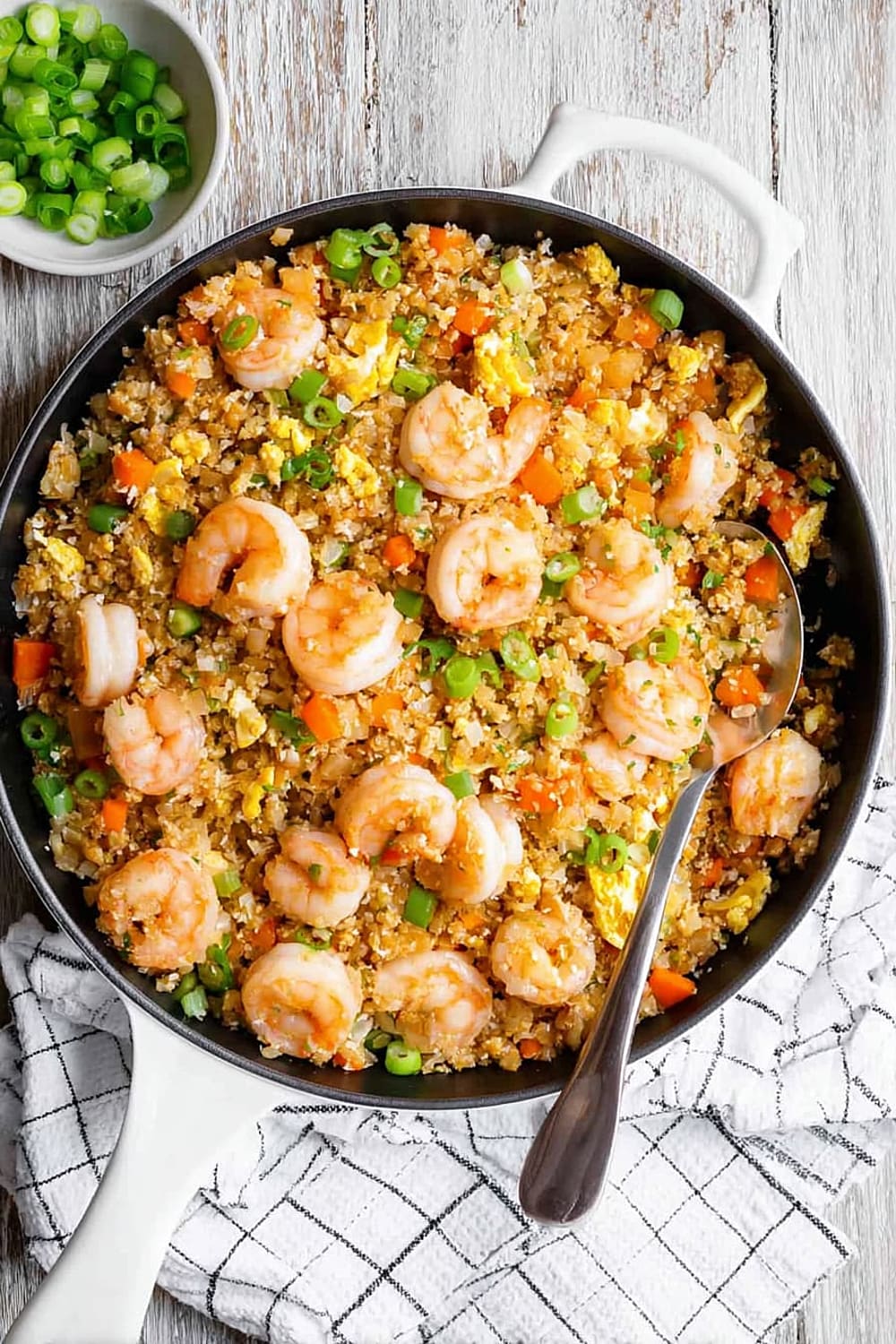
Ingredients
For the Shrimp
- 1 lb medium-large raw shrimp, peeled and deveined
- 1 tsp tapioca flour or arrowroot
- Sea salt and black pepper to taste
For the Base
- 2 Tbsp avocado oil or ghee, divided
- 3 eggs, whisked
- 1½ cups carrots, diced
- 1 bunch scallions, white and green parts separated and thinly sliced
- 1 inch chunk fresh ginger, peeled and minced (about 2 tsp)
- 3 cloves garlic, minced
- 12 oz cauliflower rice, fresh or frozen (if frozen, thaw first)
For the Sauce
- ¼ cup coconut aminos (paleo and Whole30 friendly soy sauce alternative)
- 1 tbsp pure sesame oil
- Sea salt to taste
Instructions
Preparation
- 1 Have all ingredients prepped and ready to go before beginning. This recipe moves quickly once you start cooking, so having everything measured and chopped is crucial for success.
- 2 In a medium bowl, toss the shrimp with the tapioca flour or arrowroot, salt, and pepper until evenly coated. This light coating helps the shrimp develop a beautiful golden color and prevents them from releasing too much moisture into the pan.
Cook the Shrimp
- 3 Heat a large non-stick skillet or cast iron skillet over medium-high heat. Once the pan is hot (you’ll know it’s ready when a drop of water sizzles immediately), add 1 tablespoon of avocado oil or ghee and swirl to coat the bottom.
- 4 Add the seasoned shrimp in a single layer, making sure not to overcrowd the pan. Cook for 1-2 minutes per side until they turn opaque and develop a light golden color. The shrimp should feel firm to the touch but not rubbery – this is your sign they’re perfectly cooked. Remove to a plate and reduce heat to medium.
Scramble the Eggs
- 5 With the skillet over medium heat, add the whisked eggs to the same pan. Using a silicone spatula, gently scramble the eggs until they’re just set but still slightly creamy, about 1-2 minutes. The residual heat will continue cooking them, so slightly underdone is perfect. Set them aside with the shrimp.
Build the Vegetable Base
- 6 Add the remaining tablespoon of oil or ghee to the skillet and adjust heat to medium-high. Add the diced carrots and cook, stirring frequently, for 3-4 minutes or until they’re fork-tender but still have a slight bite. You want them to retain some texture for the best eating experience.
- 7 Add the white parts of the scallions, minced ginger, and garlic to the pan. Stir to combine and cook for another 1 minute until fragrant. Your kitchen should smell absolutely amazing at this point – that’s the sign you’re doing everything right.
Finish the Dish
- 8 Add the cauliflower rice, coconut aminos, and sesame oil to the skillet. Stir everything together until well combined and cook for 2-3 minutes to soften the cauliflower rice slightly. It should be tender but not mushy.
- 9 Return the cooked shrimp and scrambled eggs to the pan. Gently stir and cook for 30-60 seconds just to heat everything through, then remove from heat immediately to prevent overcooking.
- 10 Garnish with the green parts of the scallions and season with additional coconut aminos, salt, or pepper to taste. Serve immediately while hot. Leftovers can be stored in a sealed container in the refrigerator for up to 4 days.
Recommended Equipment and Kitchen Tools
Essential Tools (for best results)
- Large non-stick skillet or cast iron skillet – A 12-inch pan gives you enough space to cook the shrimp in a single layer and prevents overcrowding, which is crucial for proper browning
- Silicone spatula – Perfect for scrambling eggs gently and stirring the cauliflower rice without breaking up the delicate ingredients
- Sharp chef’s knife – Makes quick work of dicing carrots and mincing ginger and garlic efficiently
- Cutting board – A large wooden or plastic cutting board provides ample space for all your prep work
Helpful Upgrades
- Food processor – If you’re making fresh cauliflower rice, this makes the job incredibly quick and ensures uniform texture
- Microplane grater – Creates perfectly minced ginger and garlic with minimal effort and maximum flavor release
- Digital kitchen scale – Ensures accurate measurements, especially helpful for the tapioca flour coating
- Instant-read thermometer – While not essential, it can help ensure shrimp reach the perfect internal temperature of 145°F (63°C)
Nice-to-Have Options
- Mixing bowls – Having several sizes on hand makes prep work more organized and efficient
- Measuring spoons and cups – Stainless steel sets are durable and easy to clean
- Storage containers – Glass containers with tight-fitting lids keep leftovers fresh and make reheating easy
Recipe Variations and Dietary Modifications
Protein Variations
- Chicken breast or thighs – Cut into bite-sized pieces and cook for 4-5 minutes until internal temperature reaches 165°F (74°C)
- Beef strips – Use flank steak or sirloin, sliced thin against the grain, cook for 2-3 minutes for medium doneness
- Tofu or tempeh – Cube firm tofu or crumble tempeh, cook until golden and crispy, about 3-4 minutes
- Pork tenderloin – Dice into small cubes and cook thoroughly until no pink remains
Vegetable Additions
- Bell peppers – Add diced red, yellow, or orange peppers with the carrots for extra crunch and color
- Snow peas or snap peas – Toss in during the last minute of cooking to maintain their crisp texture
- Mushrooms – Sliced shiitake or button mushrooms add earthy umami flavor
- Broccoli florets – Steam lightly first, then add with the cauliflower rice
Flavor Variations
- Spicy version – Add 1-2 teaspoons of red pepper flakes or sriracha sauce to taste
- Coconut curry style – Stir in 1 tablespoon of curry powder and 2 tablespoons of coconut milk
- Lemon herb – Add fresh herbs like cilantro or basil and a squeeze of fresh lemon juice before serving
Texture Modifications
- Extra crispy – Cook the cauliflower rice in batches to avoid steaming and achieve better texture
- Creamier eggs – Add 1 tablespoon of coconut milk to the eggs before scrambling
Nutritional Information and Health Benefits
Key Nutritional Highlights
This recipe provides approximately 280-320 calories per serving, making it a satisfying yet light meal option. Each serving delivers roughly 25-30 grams of high-quality protein from the shrimp and eggs, supporting muscle maintenance and satiety. The dish contains about 8-10 grams of healthy fats from the avocado oil and sesame oil, while keeping carbohydrates to just 8-12 grams per serving, making it ideal for low-carb and ketogenic lifestyles.
Health Benefits of Main Ingredients
Shrimp provides lean protein along with selenium, vitamin B12, and omega-3 fatty acids that support heart and brain health. The cauliflower rice is rich in vitamin C, vitamin K, and folate while providing fiber for digestive health. Fresh ginger offers anti-inflammatory compounds called gingerols, which may help reduce inflammation and support digestive function. Eggs contribute choline for brain health and complete amino acid profiles for optimal protein utilization. Carrots provide beta-carotene, which converts to vitamin A for eye health and immune function.
Dietary Considerations
This recipe is naturally gluten-free, dairy-free, paleo-compliant, Whole30-approved, and keto-friendly. It’s also low in sodium when prepared as written, making it suitable for those monitoring salt intake. The dish provides a good balance of macronutrients that helps stabilize blood sugar levels and provides sustained energy without the crashes associated with high-carb meals.
Smart Swaps and Ingredient Substitutions
Common Substitutions:
- Tapioca flour/arrowroot → Coconut flour (use half the amount) or almond flour (use same amount)
- Avocado oil → Coconut oil, olive oil, or ghee in equal amounts
- Coconut aminos → Tamari or soy sauce (if not following paleo/Whole30)
- Fresh ginger → Ground ginger (use ¼ teaspoon per teaspoon of fresh)
Budget-Friendly Swaps:
- Large shrimp → Medium shrimp or frozen shrimp (thaw completely and pat dry first)
- Fresh cauliflower rice → Frozen cauliflower rice (thaw and drain excess moisture)
- Sesame oil → Olive oil with a pinch of toasted sesame seeds for flavor
- Avocado oil → Vegetable oil or canola oil for cooking
Pantry Emergency Substitutions:
- Fresh garlic → Garlic powder (use ¼ teaspoon per clove)
- Scallions → Yellow onion (use ¼ cup diced) or chives
- Fresh cauliflower rice → Cooked quinoa or brown rice (not keto-friendly but still healthy)
- Eggs → Silken tofu scrambled with turmeric for color (vegan option)
Pro Tips for Substitutions:
- When using frozen vegetables, always thaw and drain excess moisture to prevent a watery final dish
- Coconut oil should be melted before adding to ensure even distribution
- If using regular soy sauce instead of coconut aminos, reduce the amount by half as it’s saltier
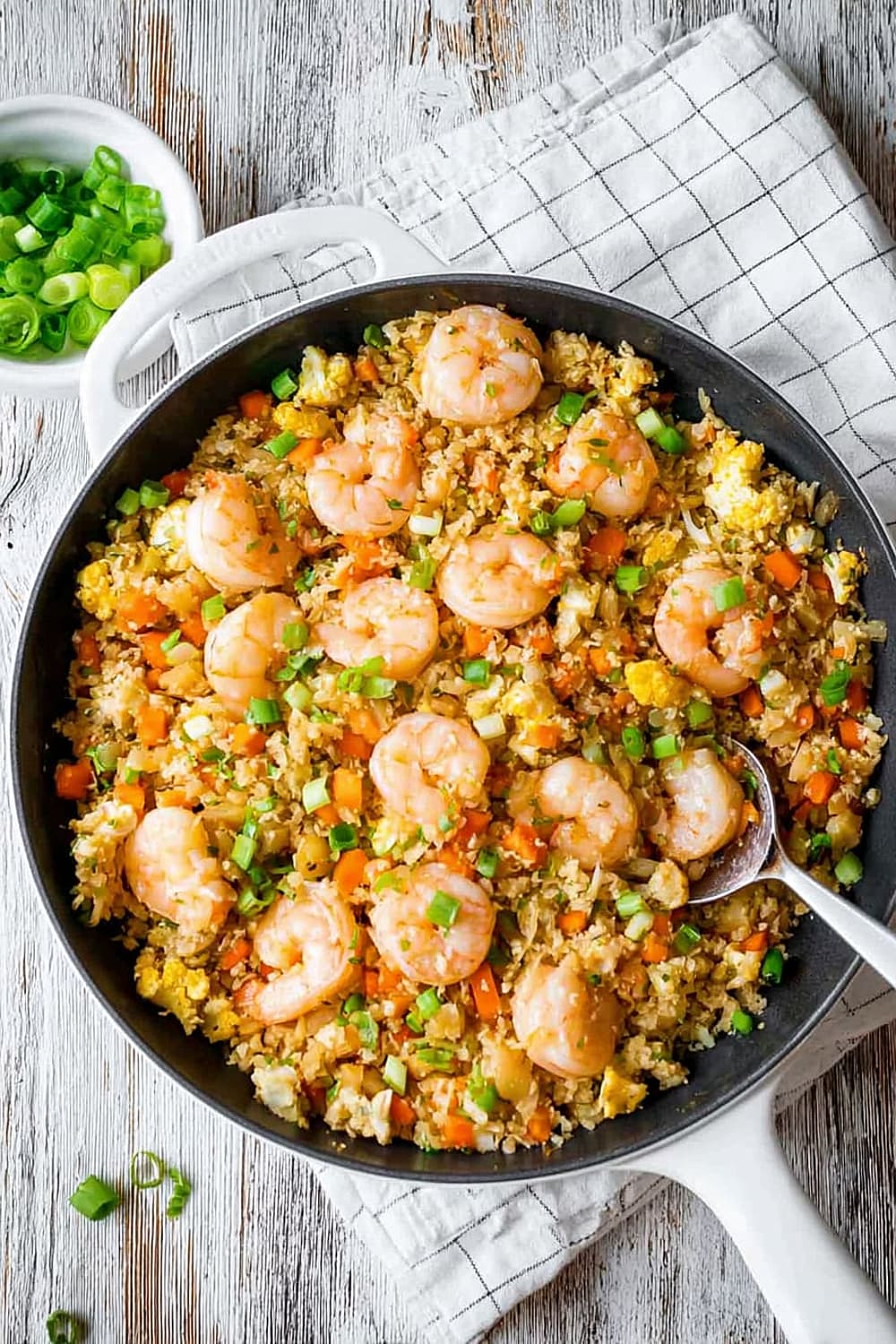
Make It Diabetes-Friendly
Carb Reduction Strategies:
- Cauliflower rice naturally keeps carbs low at only 5-6 grams per serving compared to regular rice’s 45 grams
- Eliminate tapioca flour coating on shrimp to save 2-3 grams of carbs per serving
- Use extra vegetables like bell peppers and broccoli to increase volume without adding significant carbs
- Portion control – stick to the recommended serving size to maintain 8-10 grams total carbs
Blood Sugar Management:
- High protein content (25-30g per serving) helps slow glucose absorption and maintain steady blood sugar
- Healthy fats from avocado oil and sesame oil further slow carb absorption
- Fiber from vegetables aids in blood sugar regulation and promotes satiety
- Low glycemic ingredients won’t cause rapid blood sugar spikes
Timing and Pairing Tips:
- Pair with additional protein like a small side of nuts or seeds for extra blood sugar stability
- Eat as part of a balanced meal rather than alone to optimize glucose response
- Consider portion timing – this makes an excellent lunch or dinner option
- Add extra fiber with a small side salad to further slow carb absorption
Total Carb Count: Approximately 8-10 grams net carbs per serving (total carbs minus fiber)
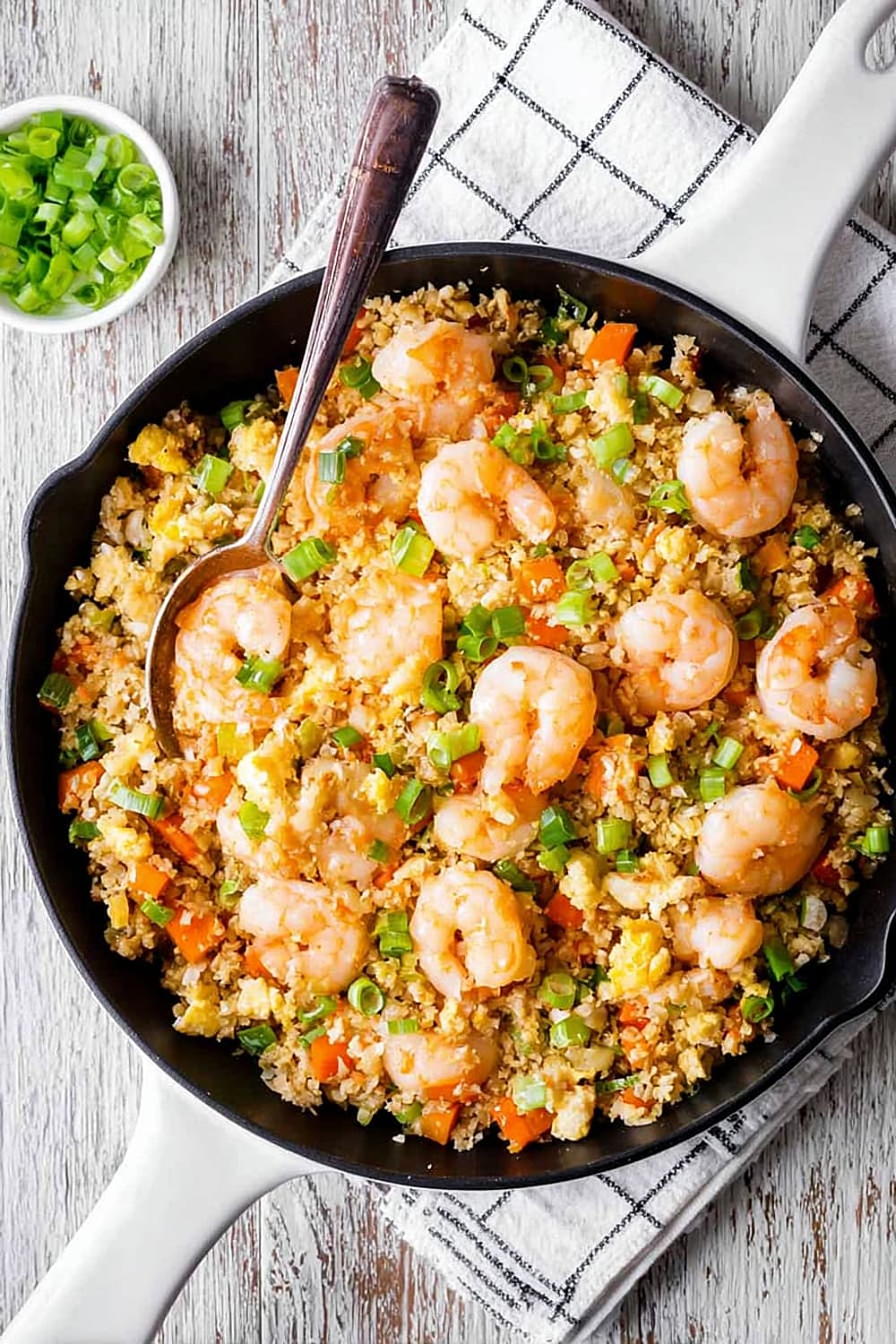
Perfect Pairing Suggestions
Beverage Pairings
A crisp Sauvignon Blanc or Pinot Grigio complements the light, fresh flavors of the shrimp and vegetables beautifully. For beer lovers, a light lager or wheat beer won’t overpower the delicate seasonings. Non-alcoholic options include sparkling water with lime, green tea, or cucumber mint water that cleanse the palate between bites. Kombucha adds probiotics and a slight tang that pairs wonderfully with the umami-rich coconut aminos.
Side Dish Recommendations
Asian cucumber salad with rice vinegar provides a cool, crunchy contrast to the warm, savory rice. Steamed edamame adds extra protein and a pop of color to the plate. Roasted bok choy or blistered shishito peppers continue the Asian flavor theme while adding different textures. A simple avocado salad with lime and cilantro provides healthy fats and creamy richness that balances the dish perfectly.
Complete Meal Ideas
Start with miso soup or bone broth as a warming appetizer. Follow the main dish with fresh fruit like sliced mango or pineapple for a naturally sweet finish. For entertaining, serve alongside lettuce wraps with the same flavor profile, creating a cohesive Asian-inspired menu. Coconut macaroons or dark chocolate make appropriate dessert choices that won’t overwhelm the clean flavors.
Occasion Suggestions
Perfect for weeknight family dinners when you want something healthy but satisfying. Excellent for meal prep Sundays since it reheats beautifully. Great for casual entertaining or potluck gatherings where you want to bring something impressive but dietary-restriction friendly. Ideal for post-workout meals due to its high protein content and quick preparation time.
Pro Tips and Troubleshooting
Professional Cooking Tips
Mise en place is crucial – have everything prepped before you start cooking since this recipe moves quickly once you begin. Don’t overcrowd the pan when cooking shrimp; work in batches if necessary to ensure proper browning. Control your heat – medium-high is perfect for searing, but reduce to medium for the eggs to prevent them from becoming rubbery. Taste and adjust seasoning at the end since coconut aminos can vary in saltiness between brands.
Common Mistakes and Solutions
Watery final dish usually means your cauliflower rice had too much moisture – always pat frozen cauliflower rice dry with paper towels before cooking. Overcooked shrimp becomes tough and rubbery – look for the color change from translucent to opaque as your doneness indicator. Mushy vegetables result from cooking too long – carrots should retain some bite for the best texture contrast.
Storage and Reheating
Store leftovers in airtight containers in the refrigerator for up to 4 days. For reheating, use a skillet over medium heat with a splash of water or broth to prevent sticking. Microwave reheating works but may make the shrimp slightly tougher. Freeze portions for up to 3 months in freezer-safe containers, though the texture of the vegetables may change slightly upon thawing.
Make-Ahead Strategies
Prep vegetables up to 2 days ahead and store in separate containers. Cook the cauliflower rice portion ahead and reheat when ready to serve. Marinate shrimp in the tapioca flour mixture for up to 4 hours for extra flavor development. The complete dish can be made ahead and reheated, though the texture is best when served fresh.
This shrimp fried cauliflower rice proves that eating healthy doesn’t mean sacrificing flavor or satisfaction. With its perfect balance of protein, vegetables, and bold seasonings, it’s destined to become a regular rotation meal that everyone in your family will actually look forward to. The best part? You’ll feel energized and satisfied instead of sluggish and guilty after eating it.